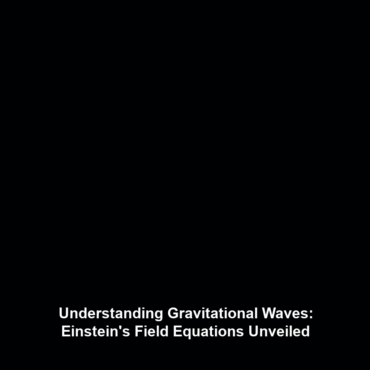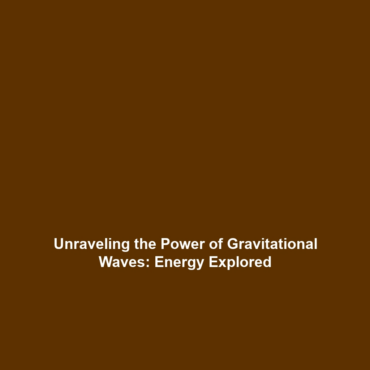Understanding Gravitational Waves: Outcomes of Einstein’s Field Equations
Introduction
The discovery of gravitational waves has marked a significant milestone in modern physics, deriving directly from Einstein’s field equations of general relativity. These ripples in spacetime not only confirmed predictions made over a century ago but also revolutionized our understanding of the universe. Gravitational waves provide insight into astronomical events such as colliding black holes and neutron stars. As we dive into how gravitational waves emerged from these fundamental equations, we uncover their essential role in the broader context of gravitational wave research.
Key Concepts
The relationship between gravitational waves and Einstein’s field equations involves several pivotal concepts:
Einstein’s Field Equations
Einstein formulated a set of ten interrelated differential equations in 1915, detailing how mass and energy influence the curvature of spacetime. These equations laid the groundwork for understanding gravitational waves.
Formation of Gravitational Waves
When massive objects accelerate, such as in the case of binary black holes spiraling towards each other, disturbances occur in spacetime that propagate as gravitational waves. The properties of these waves, including their velocity and amplitude, can be derived from the solutions of Einstein’s equations.
Detection of Gravitational Waves
The advent of advanced detectors like LIGO (Laser Interferometer Gravitational-Wave Observatory) demonstrates how gravitational waves can be observed, allowing for groundbreaking discoveries in astrophysics.
Applications and Real-World Uses
Understanding how gravitational waves emerged from Einstein’s field equations has substantial practical implications:
- Astronomy: Gravitational waves serve as a new method of observing cosmic events, opening avenues for research in astrophysics.
- Testing General Relativity: The observations of gravitational waves continuously test the predictions of Einstein’s theory, thereby refining our understanding of fundamental physics.
- Cosmology: Insights gained from gravitational waves contribute to our understanding of the early universe and the formation of cosmic structures.
Current Challenges
Despite progress, several challenges persist in the field:
- Detector Sensitivity: Improving the sensitivity of detectors remains crucial for capturing weaker signals from distant sources.
- Data Interpretation: The analysis of gravitational wave data is complex and requires advanced algorithms for accurate interpretation.
- Funding and Resources: Continued research relies on sustained funding and collaboration across global institutions.
Future Research and Innovations
The future of gravitational wave research is promising, with advancements anticipated in several areas:
- Next-Generation Detectors: Upcoming projects such as the Einstein Telescope and LIGO 2.0 aim to enhance sensitivity and detection capabilities.
- Multi-Messenger Astronomy: Researchers are exploring the synergy between gravitational waves and electromagnetic signals, leading to a more comprehensive understanding of astrophysical phenomena.
- Quantum Technologies: Innovations in quantum sensing could revolutionize the detection of gravitational waves, potentially uncovering new physics beyond the current models.
Conclusion
In summary, gravitational waves are a profound outcome of Einstein’s field equations, shaping our understanding of the universe and driving scientific exploration. As research continues, the implications of gravitational waves will expand, offering new insights into not just astrophysics, but the very nature of gravity itself. For those interested in the latest developments in gravitational wave research, explore our other articles on detection methods and recent discoveries.




